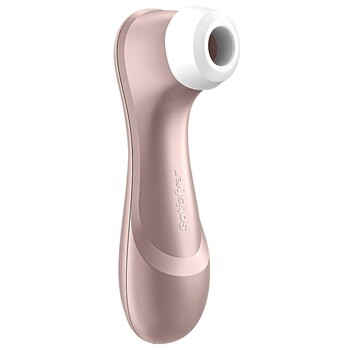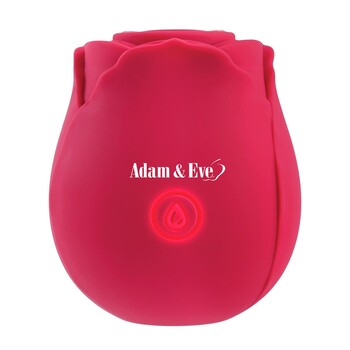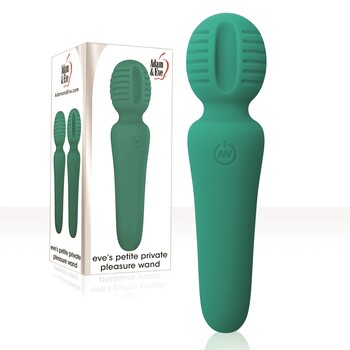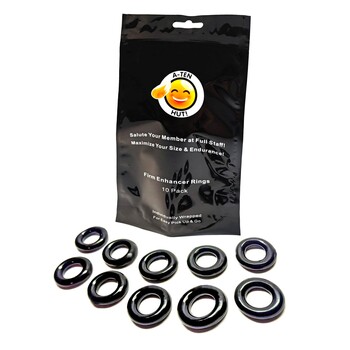When shopping for sex toys or vibrators, it’s easy to focus on the number of motors or stimulation options. But it’s just as important to see what they’re made from, especially since these toys come into close contact with your most sensitive and delicate bits.
There’s a wide range of different materials used to make sex toys, each with its own special properties. Check out the guide below for more detailed information about the most common types of sex toy materials.
Take me to:
Important Terms
ABS Plastic
Glass
Jelly
PVC
Metal
Realistics
Rubber
Silicone
TPE & TPR
Important Terms
Before jumping into all the different sex toy materials, we need to define some key terms that will come up a lot.
- Body-friendly: a material not likely to cause an allergic response that's easy to clean and maintain
- Body-safe: term used interchangeably with body-friendly
- Hypoallergenic: Many people see hypoallergenic and think it means something is 100% allergy proof. That's not exactly true. Hypoallergenic materials aren't as likely to cause a reaction as other materials, but there's still a slight chance of it happening.
- Medical-grade: meets or exceeds the same rigorous quality control standards and guidelines used in the production of medical devices
- Nonporous: A non-absorbent material without any microscopic pockets. Recommended for items that require thorough cleaning, such as butt plugs, prostate vibes, and other anal sex toys.
- Nontoxic: free from any toxic or potentially harmful materials
- Phthalate-free: doesn't contain any phthalates
- Porous: An absorbent material with microscopic pockets that can make cleaning difficult.
ABS Plastic
Acrylonitrile Butadiene Styrene (ABS) plastic is a hard material found in many budget-friendly sex toys. It’s also used in high-end vibrators for the base or handle. Many common household items are made from ABS plastic, including computer keyboards and even Lego pieces.
General Health & Safety: ABS plastic is not known to cause any health issues, making it a body-safe material and nontoxic material.
Lube: ABS plastic is compatible with all types of sex lubes.
Cleaning: As a nonporous material, ABS plastic can be cleaned easily. Simply wash it in warm, soapy water or spray it with a sex toy cleaner.
Storage: Toys made from ABS plastic should be stored in cool, dark locations. Any other special measures are not necessary.
Glass
Some of the most beautiful sex toys you can buy are made from glass. Its ability to stay warm or cold makes glass highly prized for temperature play.
General Health & Safety: Glass is not associated with any known health problems, making it completely safe to use and enjoy. Some sex toy users, however, worry about their glass toy chipping or cracking. Glass sex toys are typically made from borosilicate glass. This is the same type of glass used in cookware, so it’s extremely durable and shatter-resistant. In other words, your glass dildo won’t break if you accidentally knock it off the bed.
Lube: Glass is compatible with all types of lubes, including silicone-based and water-based ones.
Cleaning: Glass is a nonporous material, which makes it extremely easy to clean. You can wash glass sex toys in warm, soapy water or with a sex toy cleaner. You can dip un-powered glass toys in boiling water or even run them through your dishwasher.
Storage: Glass sex toys can be stored almost anywhere safely. Some more adventurous couples even display them as a piece of art.
Jelly
Found mainly in budget-friendly sex toys, jelly is a soft and flexible material. It was one of the most popular sex toy materials just a decade ago, but it has been overtaken in recent years by more durable materials such as TPE and TPR.
General Health & Safety: Many sex toy experts recommend slipping a condom on your jelly toy before using it. If you want to share your jelly toy or use the same one for both anal and vaginal penetration, then you definitely need to use a condom. Some jelly toys can have a strong smell, especially after sitting in a hot delivery truck for hours. If the smell bothers you, try washing your toy several times with a deodorizing sex toy cleaner and letting it air out.
Lube: Jelly toys are compatible with water-based and silicone-based lubes. Do not use them with oil-based lubes such as KY.
Cleaning: Jelly is an extremely porous material, which can make cleaning a challenge. Porous materials have microscopic pockets in their surface that can harbor germs or bacteria. Always wash your jelly toys with a mild soap or toy cleaner before drying them with a lint-free cloth.
Storage: Keep your jelly toys in a cool, dark location. Extreme temperatures or prolonged exposure to direct sunlight can damage them.
Metal
Metal, most often stainless steel or aluminum, is found in dildos, anal toys and high-end vibrators. Metal can also be used for temperature play just like glass to increase your stimulation options.
General Health & Safety: Some metal sex toys can contain nickel, even in medical-grade stainless steel. If you have a nickel allergy, you should double-check that any metal sex toy is nickel free before using it. Otherwise, metal sex toys are nontoxic and completely safe to use.
Lube: Metal is compatible with all types of lube.
Cleaning: Metal is another nonporous material. Wash it in warm, soapy water or spray it with a sex toy cleaner after use. You can also dip un-powered metal toys in boiling water. Dry your metal toy thoroughly after use.
Storage: Keep your metal sex toys in a dry location.
PVC
Polyvinyl chloride (PVC) is one of the most commonly used plastics in the world. It’s used in everything from bottles to plumbing. PVC is prized among sex toy manufacturers for its versatility. PVC toys can be soft and flexible or firm and hard depending on how they’re made.
General Health & Safety: Some sex toy experts recommend using a condom with your PVC toy. It’s especially important to use a condom if you intend to use a soft PVC toy for both anal and vaginal penetration or share it with someone else because it can be a porous.
Lube: PVC is compatible with water-based and silicone-based lubes. Do not use oil-based lubes such as KY.
Cleaning: PVC can be nonporous or porous depending on how it’s made. Hard PVC toys are nonporous, which makes them easy to clean. Soft PVC toys are porous, which means they contain microscopic pockets that can be challenging to clean. (Not sure if your PVC toy is hard or soft? If you can bend it, then it’s soft.) Use warm water and antibacterial soap or a sanitizing sex toy cleaner to wash your PVC toys. Then dry them off with a lint-free cloth. If you’ve got a soft PVC toy, make sure to clean it extra thoroughly before and after each use.
Storage: Keep your PVC toys in a cool, dark location such as the drawer in your nightstand. Soft PVC toys should be stored in their own bags.
Realistics
These materials are designed to mimic the feel of human skin and are often used in masturbators as well as some dildos and vibrators. Most sex toy manufacturers have their own specially trademarked version of realistic material, such as Cyberskin or UR3.
General Health & Safety: Most realistic materials are based on TPE or TPR with special additives that give them their unique feel. As such, realistic materials are nontoxic and safe to use. Many sex toy experts suggest using a condom if you intend to use the same toy for both anal and vaginal penetration or share it with someone else.
Lube: Compatible with water-based and silicone-based sex lubes.
Cleaning: Realistic materials are porous, so they should be cleaned thoroughly before and after each use. Wash your realistic toys in warm water with a gentle soap or use a sex toy cleaner. Pat it dry with a lint-free cloth. Once the toy is completely dry, lightly dust it with a special preservative powder. In a pinch, you can substitute corn starch to preserve the realistic material’s unique texture.
Storage: These sex toys should be stored in cool, dark locations. Keep each realistic toy in its own sealed plastic bag with a small spoonful of corn starch.
Rubber
This material is usually found in budget-friendly sex toys that need to balance firmness and flexibility, such as anal toys. Rubber is also widely used in inflatable dildos and butt plugs.
General Health & Safety: Rubber toys can contain latex, so you should check the label carefully before buying if you have a sensitivity or an allergy. Sex toy experts recommend using a condom with these toys before using them. Condoms are essential if you plan to share your rubber toy or use it for both anal and vaginal penetration.
Lube: Rubber is safe to use with water-based and silicone-based sex lubes. Do not use an oil-based lube such as KY.
Cleaning: Rubber is a porous material that should be thoroughly cleaned before and after each use. Wash it in warm water with an antibacterial soap or use a sex toy cleaner. Dry it off with a lint-free cloth.
Storage: Rubber toys should be stored in their own individual bags in a cool, dark location. Make sure your rubber toys do not come into contact to avoid potentially damaging them.
Silicone
Silicone is the material of choice for many high-end sex toys and vibrators. Depending on how it’s made, silicone can be firm to the touch or flexible. You can also find it in bakeware and cooking utensils. Silicone also has many other medical applications.
General Health & Safety: Silicone is a chemically-stable material, which makes it nontoxic and safe for use. Silicone is also hypoallergenic, which means that it’s not likely to cause an allergic reaction. These reasons are why silicone is commonly described as body friendly or body safe.
Lube: Never use a silicone-based lube with a sex toy containing silicone. The two can potentially damage your toy. Water-based lubes, however, are perfectly safe to use.
Cleaning: Silicone is a nonporous material, which makes it easy to care for and clean. You can wash silicone toys in warm, soapy water or with an antibacterial sex toy cleaner. You can even dip un-powered silicone toys in boiling water.
Storage: Silicone toys should be stored in lint-free bags in a cool, dark location. Do not store two silicone toys in the same bag or anywhere else they might come into contact with each other. This could damage both toys.
TPE & TPR
Thermoplastic elastomer (TPE) and thermoplastic rubber (TPR) are so similar that you practically need a master’s degree in chemical engineering to tell them apart. TPE is visually similar to silicone and slightly more durable. TPR has a more gel-like look and rubbery feel. Both materials are very soft and flexible. They can be found in vibrators, dildos and masturbators among other sex toys. And you can find them around your home in everything from bicycle handles to catheters.
General Health & Safety: Don’t let the thermoplastic in their name scare you. That simply means both materials can be heated to high temperatures and molded into a wide variety of shapes. TPE and TPR are both nontoxic materials and completely safe to use. They are porous, however, so you need a condom if you want to use the same toy for vaginal and anal penetration or share it with someone else.
Lube: Compatible with water-based and silicone-based sex lubes.
Cleaning: As porous materials, it’s important to clean TPE and TPR sex toys as thoroughly as possible before and after each use. Wash them with a mild soap and warm water or use a sex toy cleaner. Dry them carefully with a lint-free cloth.
Storage: Store TPE and TPR toys in a cool, dark location with each toy in its own bag to prevent them from coming into contact with your other toys.





